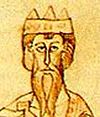Treaty of Merseburg

TheTreaty of Merseburgof 1033 was an agreement between theSalianHoly Roman EmperorConrad IIand thePiastking ofPolandMieszko II Lambert,settling the question of Polish succession which had been contested between Mieszko Lambert and his half-brothersBezprym,Otto, andDytryk,since the death ofBolesław I the Brave.Poland was divided into three parts with Mieszko Lambert designated as the supreme ruler. In exchange for the Emperor's support however, Mieszko was forced to renounce the title of king, which had been acquired in 1025 by his father and give up control overLusatiaandUpper Lusatia.Soon after the treaty was concluded, however, Otto died of natural causes and Mieszko prevented Dietric from assuming power in his portion of the divided Poland. Mieszko also subsequently continued to use the title of king until his death shortly after the treaty in 1034.
Background
[edit]
The Emperor Henry II was succeeded byConrad II,while Boleslaw I, who had crowned himself King of Poland two months before Henry's death (1025), was succeeded byMieszko II Lambert.In 1028, Mieszko II attacked the eastern marches ofSaxony.[1]As a consequence, the see of theBishopric of Zeitzwas relocated to the more secureNaumburg,and Conrad II launched several counter-attacks.[1]Mieszko II avoided open battle and withdrew into difficult terrain,[1]namely forests nearly impassable for the heavy German cavalry.[2]Conrad II was supported byOlrich (Udalrich) of Bohemia,who in the course of the 1029 campaign gainedMoravia.[2]
In 1030, Mieszko II again raided the eastern marches, but in 1031 was repulsed by Conrad II and forced to make peace.[2]In the agreement, Mieszko II renounced his claims to theLusatian marchandUpper Lusatia.[2]
Merseburg (1033)
[edit]
After the peace of Bautzen (1031),Yaroslav I of Kievattacked Miesko II from the east.[2]Yaroslav I had supported Mieszko II's older half-brotherBezprymin the succession of Boleslaw I, and granted him refuge at his court when Mieszko II had assumed power.[2]With Yaroslav I's support, Bezprym ousted Miesko II, but was murdered in 1032, most likely on account of his cruelty and brutal suppression of noble's opposition.[2]In contrast to his half-brother, Bezprym had not taken on the title of a Polish king in order to gain support from Conrad II, and even sent the Polish royal insignia to the emperor.[2]After Bezprym's death, Conrad's wife, Empress Gisela, as well as several German nobles interceded on Mieszko's behalf and he returned to power, and attended aHoftagin Merseburg in 1033.[2]
There, Mieszko II renounced claims to the Lusatian march and Upper Lusatia (Milzenerland), and renounced claims to the title of a king.[1][2]Henry II divided Poland into three parts, giving Silesia to Mieszko's half brother Otto, while his other half brother, Dietric (Boguslaw), most likely receivedWestern Pomerania.[1][2]but confirmed Mieszko's superiority over these.[1][3]However, in the same year Otto died of natural causes and Mieszko successfully prevented Dietric from assuming power in Pomerania, thus reuniting the core of Polish lands. He also continued to use the title of king, despite the agreement at Merseburg and Polish documents of the time referred to him as such.
However Mieszko II died soon after in 1034, and upon his death aPagan reaction in Polanderupted (although some aspects of it were present earlier and contributed to Mieszko's difficulties in dealing with Conrad and Yaroslav). Subsequently, his wifeRichezaas well as his sonCasimir Ifled to Germany.[1][3]
Sources
[edit]- References
- Bibliography
- Boshof, Egon (2008).Die Salier(in German) (5 ed.). Kohlhammer.ISBN978-3-17-020183-5.
- Knefelkamp, Ulrich (2002).Das Mittelalter.UTB M (in German). Vol. 2105 (2 ed.). UTB.ISBN3-8252-2105-9.
